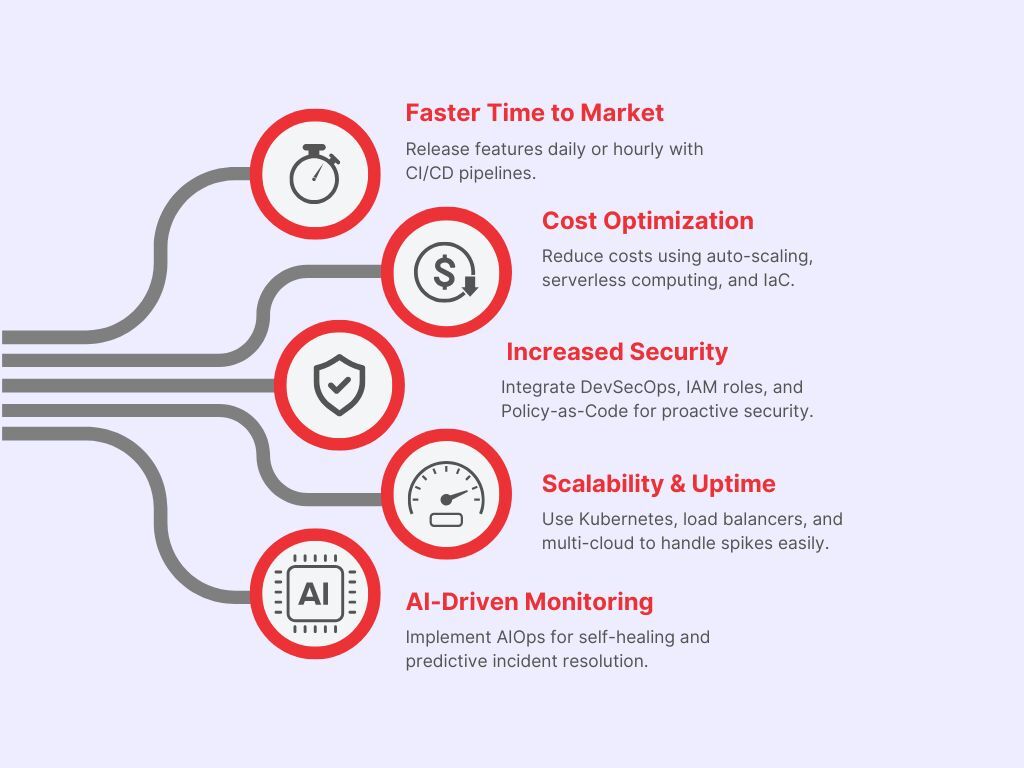In today’s fast-paced digital world, businesses must deliver software faster, scale efficiently, and maintain high availability while keeping costs under control. This is where Cloud DevOps emerges as a game-changer. It integrates cloud computing and DevOps methodologies to enable continuous delivery, automation, and security at scale.
In this blog, we’ll explore the importance, benefits, and best practices of Cloud DevOps and how it is shaping the future of IT operations.
What is Cloud DevOps?
Cloud DevOps is a fusion of DevOps principles (collaboration, automation, CI/CD, and monitoring) with cloud-native technologies (Kubernetes, serverless computing, and multi-cloud strategies). It enables businesses to:
- Deploy software faster and more reliably.
- Automate infrastructure management.
- Enhance security through DevSecOps practices.
- Optimize cloud costs while maintaining high performance.
Unlike traditional DevOps, Cloud DevOps takes advantage of elastic cloud resources, microservices, and containerization to achieve scalability and agility.
Business Benefits of Cloud DevOps
1. Faster Time to Market
With automated CI/CD pipelines, companies can release new features daily or even hourly, rather than in weeks or months. This provides a competitive edge in industries like e-commerce, finance, and healthcare.
2. Cost Optimization & Efficiency
Cloud DevOps reduces infrastructure costs by using serverless computing, auto-scaling for fluctuating workloads, and optimizing resource usage with Infrastructure as Code (IaC).
3. Increased Security & Compliance
By integrating security into the DevOps pipeline (DevSecOps), companies can detect vulnerabilities early, secure cloud access with IAM roles, and ensure compliance with regulations like GDPR and HIPAA.
4. Scalability and High Availability
Cloud DevOps enables on-demand scaling of applications to handle traffic spikes and maintain high uptime using Kubernetes clusters, load balancers, and multi-cloud strategies.
5. AI-Driven Monitoring & Observability
Modern Cloud DevOps integrates AI-powered AIOps for predictive analytics and self-healing infrastructure, using observability tools like Prometheus, Grafana, and Datadog.

Best Practices for Implementing Cloud DevOps
- Use Infrastructure as Code (IaC) for Automation – Tools like Terraform, AWS CloudFormation, and Ansible ensure consistent and repeatable cloud deployments.
- Implement CI/CD Pipelines for Faster Releases – Using Jenkins, GitHub Actions, or GitLab CI/CD, businesses can automate testing and deployments seamlessly.
- Leverage Kubernetes for Container Orchestration – Kubernetes simplifies scaling, deployment, and management of containerized applications.
- Monitor & Optimize Cloud Costs (FinOps) – Adopting FinOps practices helps track cloud spending and optimize resource allocation.
- Adopt a Multi-Cloud or Hybrid Cloud Strategy – Using AWS, Azure, and Google Cloud together prevents vendor lock-in and improves resilience.
Future Trends in Cloud DevOps
- GitOps & AI-driven DevOps – GitOps tools like ArgoCD & Flux automate Kubernetes deployments.
- Serverless DevOps – FaaS (Function-as-a-Service) will simplify cloud-native application development.
- DevSecOps as a Standard – Security-first approach will become the default in CI/CD pipelines.
- NoOps & AIOps – AI-driven automation will eliminate manual operational tasks.
Conclusion
Cloud DevOps is revolutionizing the way businesses develop, deploy, and maintain applications. It enables:
✅ Agility – Faster releases and better collaboration.
✅ Scalability – Seamless growth without infrastructure bottlenecks.
✅ Security – Proactive security and compliance automation.
✅ Cost Efficiency – Pay-for-what-you-use cloud models.
As businesses continue to embrace digital transformation, Cloud DevOps is no longer an option—it’s a necessity. 🌟






Koyal
Hi